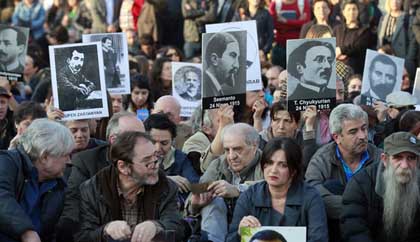Forced Islamisation of Armenians raises questions about today’s Turkey
- (0)

By NAT De Polis
Ethnic and religious cleansing accompanied the genocide perpetrated by the Young Turks and the construction of Ataturk’s new Turkey. Millions of Turks are related to Armenians. Crypto-Armenians and Crypto-Christians are now breaking their silence.
Istanbul (AsiaNews) – Turks are getting ready for a hot election in March when they will cast their ballot to elect a new parliament and, for the first time, a new president. Almost certainly, Sunni ethics will certainly inform the debate. Not much coverage has gone to a conference held in early November on the forced islamisation of Armenians before and after the 1915 genocide.
Organised by Istanbul’s Boğaziçi University and the Hrant Dink Foundation, which is named after Turkish-Armenian journalist Hrant Dink, the editor of the bilingual Turkish-Armenian newspaper Agos. He was assassinated in 2007 by Turkish nationalists with the tolerance of elements within the Turkish state.
Although some 600 people from around the world attended the conference, the Turkish media failed to give the event the attention it deserved.
In their presentations, various speakers noted that forced Islamisation was not visited only on individual children and women survivors but on entire families forced to convert in order to survive in the new Turkey born out of the ashes of the Ottoman Empire.
The founding of the new Turkish Republic was premised on the policies of Islamisation and genocide pursued by the Young Turks and the Committee of Union and Progress. This occurred after Armenian members of the Young Turks and the Committee split from ethnic Turks in 1913.
Based on various reports, the goal of the Committee of Union and Progress in 1915 was to reduce the Armenian population (5 to 10 per cent of the empire’s population) where it had its strongest and oldest roots – the central, southern and eastern regions of the Ottoman Empire – since its aim was to establish a new Turkey that would be Sunni Muslim. Even Kemal Ataturk, founder of Turkey’s so-called secular republic, appealed to Muslim solidarity to consolidate his power. In short, a real Turk was a Muslim Turk.
Not surprisingly, after the Treaty of Lausanne (1923), Turkish-speaking Orthodox Christians known as Karamanlis were uprooted from Anatolia and sent to Greece.
Turkish historian Taner Akçam, who teaches at Clark University in the United States, is one of the foremost specialist on the Armenian Genocide. In his address, he spoke of 200,000 Islamised Armenians, noting that the assets of the genocide victims went to the Turks.
Overall, historians focused on a very important issue. Because of forced islamisation, millions of Turks have ties to the Armenian and/or Christian communities. Some call them ‘crypto-Armenians’ or ‘crypto-Christians;.
In her lecture, French sociologist Laurence Ritter presented research showing that 100 years after the Armenian Genocide, the descendants of Islamised Armenian survivors, the so-called crypto-Armenians of Anatolia, are beginning to break their silence.
Ayşe Gül Altınay, who teaches at Sabanci University, a private college in Istanbul, said that Hrant Dink, the murdered editor of the Istanbul-based Turkish-Armenian newspaper Armenian Agos, back in 2004 called for the Armenian Genocide to be revisited in light of the descendants of Islamised Armenians.
Ayşe Gül Altınay and Fethiye Çetin edited a book, The Grandchildren, released in 2007, in which they note that the Turkish state knew about the ethnic make-up of the population. Contrary to the official ideology, Turks were not as homogenous as the government wanted them to be.


















